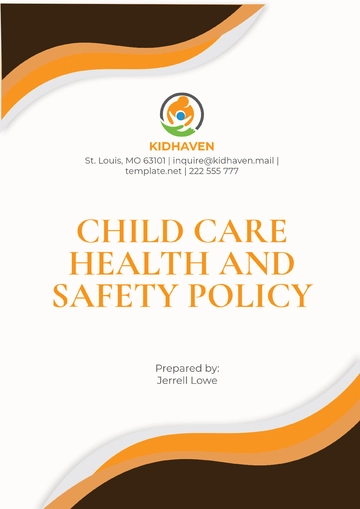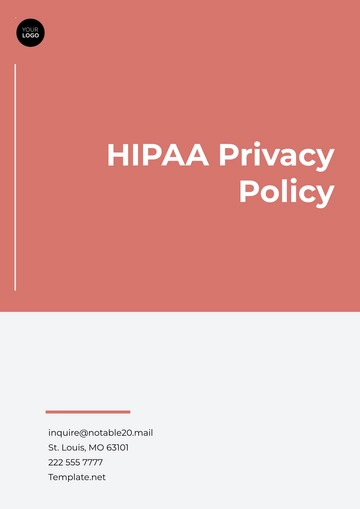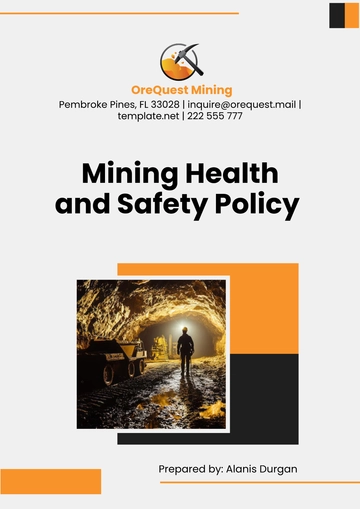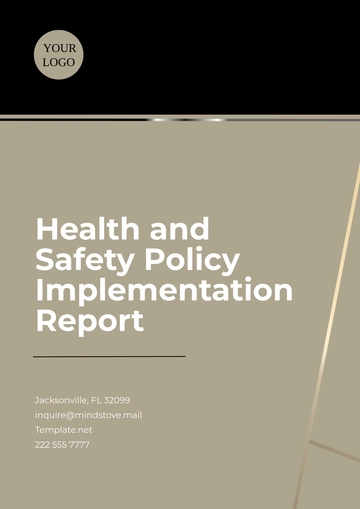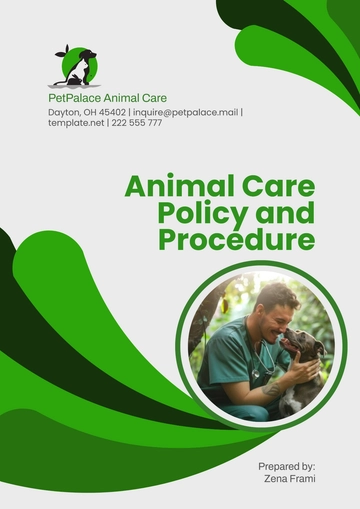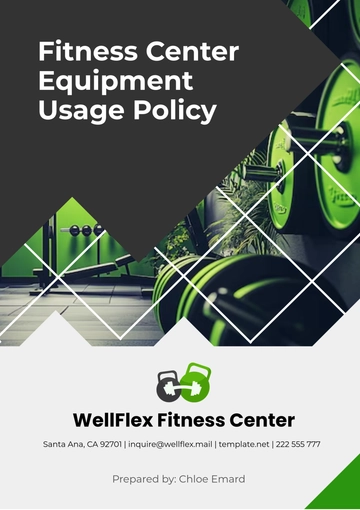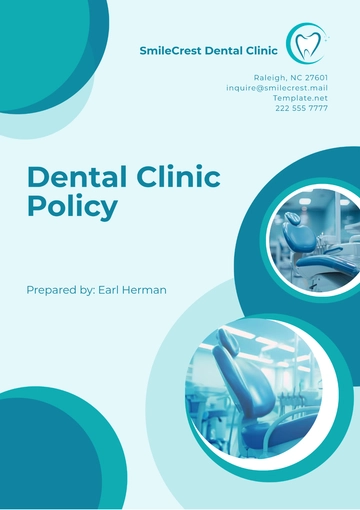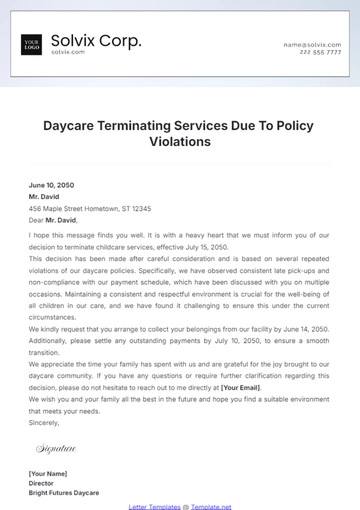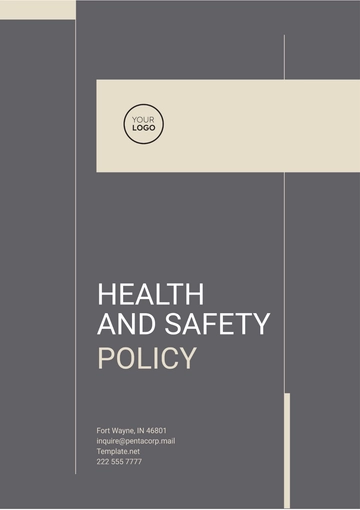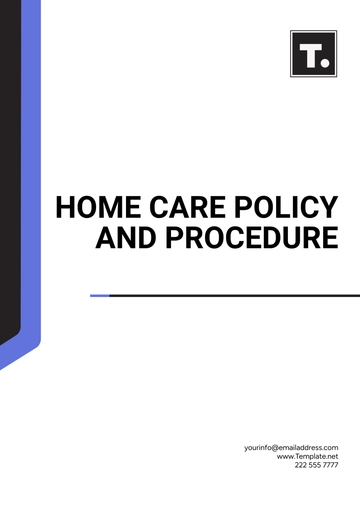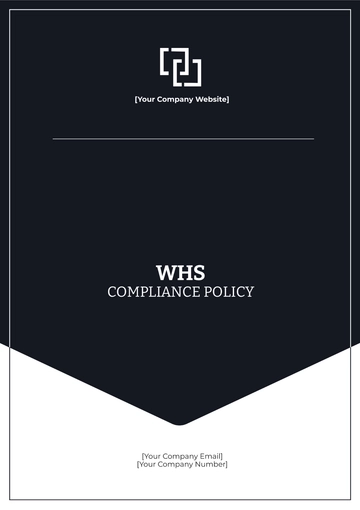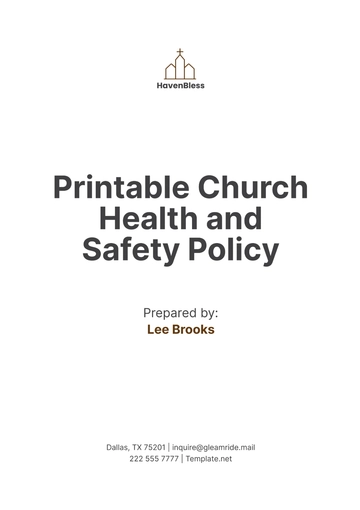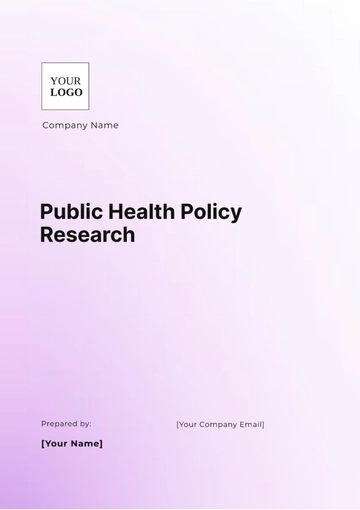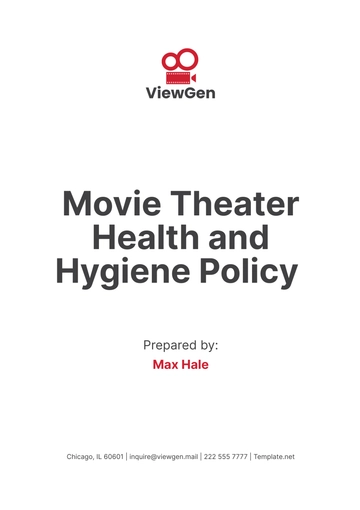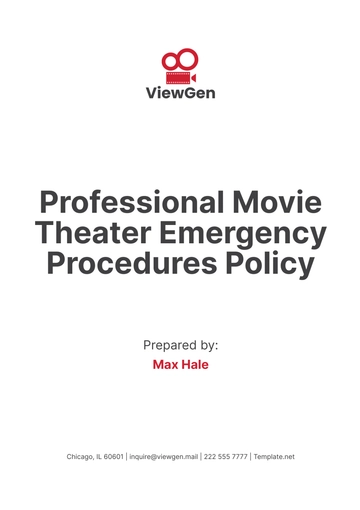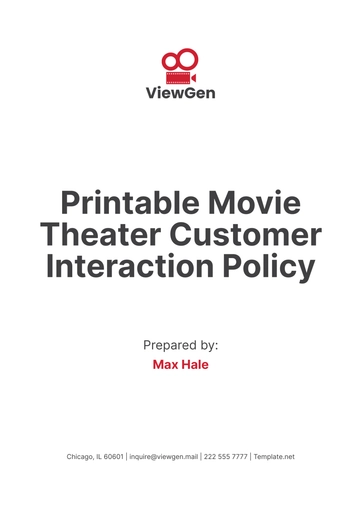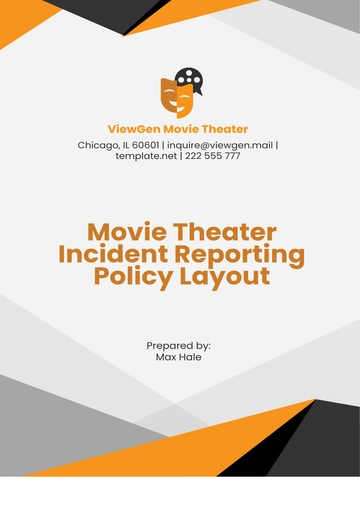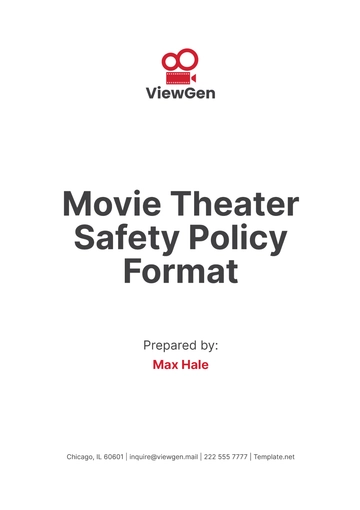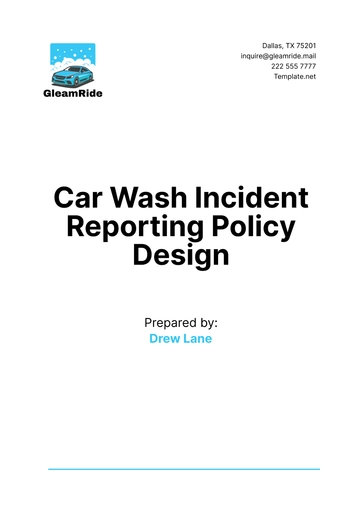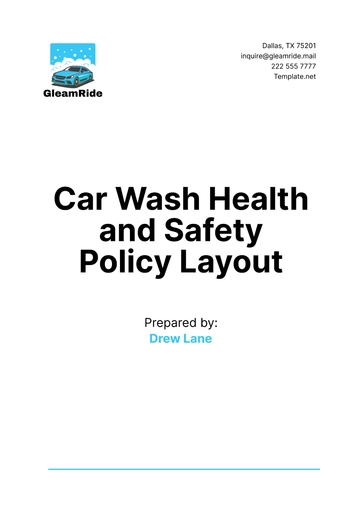Free Nursing Home Restraint-Free Care Policy
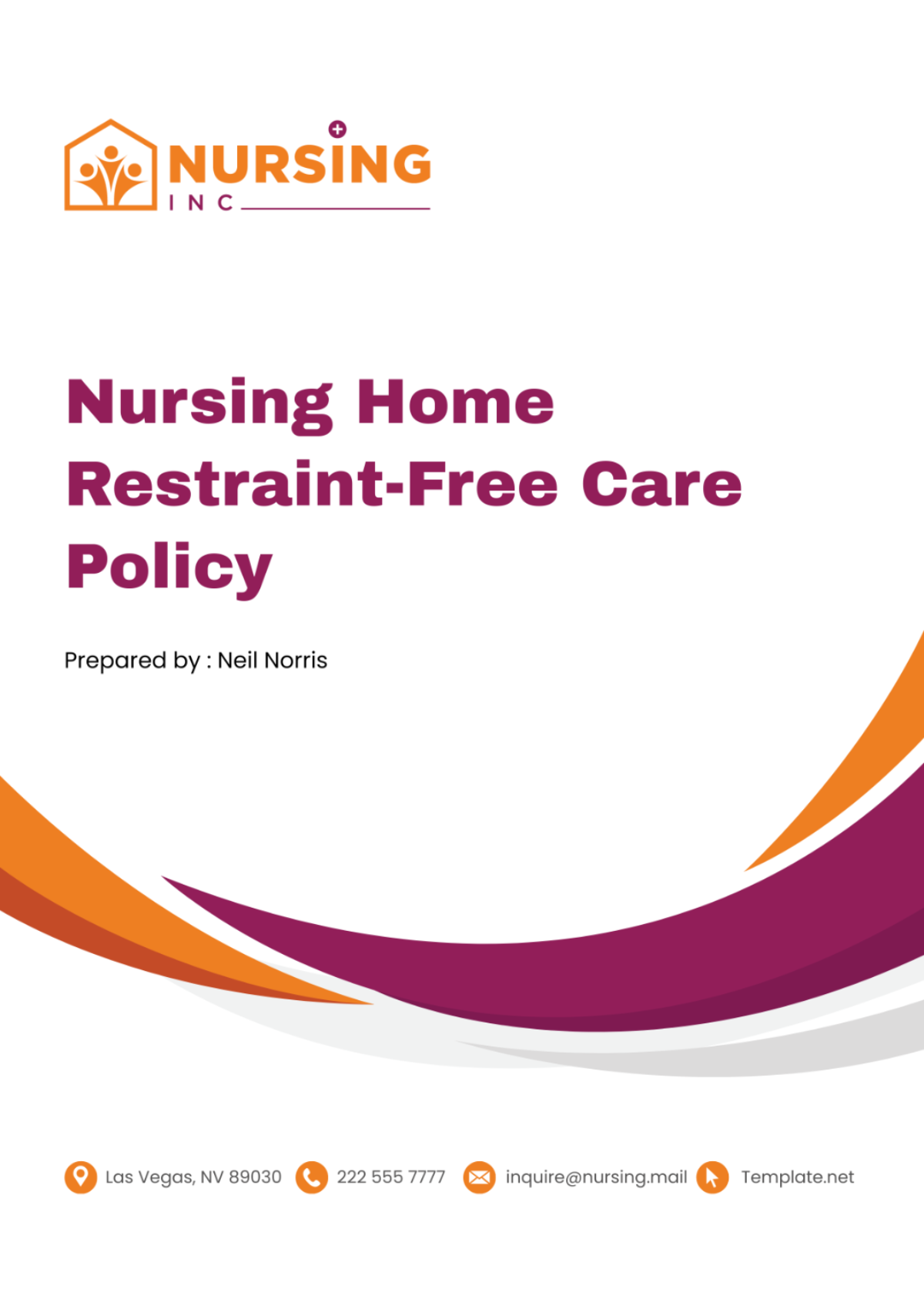
I. Introduction
A. Purpose
The primary goal of the Restraint-Free Care Policy at [Your Company Name] is to uphold the dignity, autonomy, and well-being of our residents by minimizing the use of physical restraints. This policy aims to establish guidelines and procedures that promote a culture of person-centered care and foster a supportive environment where residents can thrive while maintaining their independence.
B. Scope
This policy applies to all staff members, including healthcare professionals, caregivers, administrative staff, and volunteers, who are involved in providing care and support to residents at [Your Company Name]. It encompasses all areas of resident care, including but not limited to daily activities, medical interventions, and behavioral management.
C. Definitions
For the purpose of this policy, the following definitions apply:
Term | Definition |
|---|---|
Restraint | Any device, material, or equipment attached to or near a resident’s body that restricts freedom of movement. |
Restraint-Free Care | Providing care to residents without the use of physical restraints, emphasizing alternative interventions and person-centered approaches. |
II. Principles of Restraint-Free Care
A. Resident-Centered Care
At [Your Company Name], we are committed to providing care that honors the individual preferences, choices, and rights of each resident. Our approach to restraint-free care prioritizes the autonomy and dignity of residents, ensuring that their voices are heard and respected in all aspects of their care journey.
B. Risk Assessment
Prior to considering the use of any form of restraint, a comprehensive assessment of the resident's physical and cognitive abilities, medical condition, and behavioral patterns must be conducted by qualified healthcare professionals. This assessment should take into account factors such as mobility, fall risk, agitation levels, and any underlying medical conditions that may influence the need for interventions.
The risk assessment process should involve collaboration among interdisciplinary team members, including nurses, physicians, therapists, and social workers, to gather comprehensive information and develop individualized care plans tailored to each resident's unique needs and circumstances.
It is imperative that the risk assessment is an ongoing process, regularly reassessed and updated as the resident's condition or care needs change over time. This ensures that interventions remain appropriate, effective, and aligned with the resident's evolving preferences and goals of care.
C. Least Restrictive Intervention
Restraints should only be considered as a last resort when all other less restrictive interventions have been explored and deemed ineffective in addressing the resident's needs or ensuring their safety. The decision to use restraints must be justified based on the individual resident's assessed risks and clinical indications, with careful consideration given to the potential benefits and risks associated with restraint use.
Whenever possible, alternative strategies and interventions should be utilized to address the underlying causes of agitation, wandering, or challenging behaviors, with a focus on addressing unmet needs, promoting comfort, and enhancing the resident's quality of life.
Examples of alternative interventions may include environmental modifications, personalized care plans, therapeutic activities, behavioral management techniques, and supportive approaches that empower residents to maintain their independence and autonomy while ensuring their safety and well-being.
D. Informed Consent
Residents or their legal representatives have the right to be fully informed of the risks and benefits associated with the use of restraints, including potential physical and psychological effects, as well as alternative options available for managing their care needs.
Informed consent should be obtained from the resident or their authorized decision-maker before implementing any form of restraint, except in emergency situations where there is an immediate risk of harm to the resident or others, and obtaining consent is not feasible.
The consent process should involve a meaningful discussion between the healthcare team and the resident or their representative, providing an opportunity for the resident to express their preferences, concerns, and goals of care, and actively participate in decision-making regarding their treatment and care interventions.
E. Staff Training and Education
All staff members involved in the care of residents at [Your Company Name] shall receive comprehensive training and education on restraint-free care principles, de-escalation techniques, and alternative interventions, as part of their orientation and ongoing professional development.
Training programs should be designed to enhance staff members' knowledge, skills, and confidence in identifying and addressing residents' care needs without resorting to the use of physical restraints, emphasizing the importance of person-centered approaches, communication strategies, and teamwork in promoting resident safety and well-being.
Ongoing education and training opportunities should be provided to staff members to ensure they remain up-to-date on current best practices, evidence-based guidelines, and regulatory requirements related to restraint-free care, fostering a culture of continuous learning and quality improvement within the organization.
III. Restraint-Free Care Strategies
A. Environmental Modifications
[Your Company Name] is committed to creating a safe and supportive environment that promotes resident mobility, independence, and well-being. Environmental modifications play a crucial role in minimizing the need for physical restraints and enhancing the overall quality of life for residents. The following strategies will be implemented to optimize the physical environment:
Strategy | Description |
|---|---|
Ensure adequate lighting | Ensure that all areas within the facility are well-lit to enhance visibility and reduce fall risks. |
Implement non-slip flooring | Install non-slip flooring in common areas, bathrooms, and resident rooms to prevent slip and fall accidents. |
Remove environmental hazards | Regularly assess the environment for potential hazards such as loose rugs, clutter, or obstacles, and promptly address them to ensure resident safety. |
Create clear pathways | Maintain clear and unobstructed pathways throughout the facility to facilitate resident mobility and navigation. |
B. Personalized Care Plans
Individualized care plans are essential for providing resident-centered care that meets the unique needs, preferences, and goals of each resident. These care plans should be developed in collaboration with the resident, their family members, and the interdisciplinary care team, and should address the following key components:
Component | Description |
|---|---|
Comprehensive assessment | Conduct a thorough assessment of the resident's physical, cognitive, and psychosocial needs and abilities to identify areas requiring support and interventions. |
Identification of triggers | Identify potential triggers for agitation, wandering, or challenging behaviors, and develop strategies to mitigate these triggers in the care plan. |
Goal setting | Collaboratively establish realistic and meaningful goals with the resident and their family members to guide care planning and measure outcomes. |
Interventions and strategies | Outline specific interventions and strategies to address the resident's care needs, promote independence, and enhance quality of life while minimizing the use of restraints. |
C. Staff Supervision and Monitoring
Close supervision and monitoring of residents are essential components of effective restraint-free care. Staff members should be vigilant in observing residents for signs of agitation, distress, or behavior changes and intervene promptly to prevent escalation. The following measures will be implemented to enhance staff supervision and monitoring:
Measure | Description |
|---|---|
Regular rounds | Conduct regular rounds by nursing staff and caregivers to check on residents, assess their well-being, and address any emerging needs or concerns. |
Use of monitoring technology | Utilize monitoring technology such as video surveillance or sensor alarms to enhance supervision and alert staff to potential safety risks or incidents. |
Communication and collaboration | Encourage open communication and collaboration among staff members to share observations, discuss resident care needs, and coordinate responses to challenging situations. |
D. Therapeutic Interventions
Therapeutic interventions play a crucial role in promoting resident comfort, engagement, and emotional well-being without resorting to the use of physical restraints. These interventions should be tailored to each resident's preferences, interests, and therapeutic goals and may include the following approaches:
Intervention | Description |
|---|---|
Music therapy | Offer individualized music therapy sessions or group music activities to promote relaxation, reduce anxiety, and improve mood among residents. |
Pet therapy | Arrange for visits from therapy animals or provide opportunities for residents to interact with pets to enhance emotional support and socialization. |
Sensory stimulation | Provide sensory stimulation activities such as aromatherapy, massage, or tactile stimulation to promote relaxation, sensory integration, and emotional regulation. |
E. Staff-to-Resident Ratio
Maintaining appropriate staffing levels is essential for ensuring residents receive the individualized attention, support, and assistance they need to thrive in a restraint-free environment. [Your Company Name] is committed to maintaining adequate staff-to-resident ratios to support resident care and safety, including:
Measure | Description |
|---|---|
Staffing assessments | Conduct regular assessments of staffing needs based on resident acuity, care requirements, and facility size to ensure adequate coverage and support. |
Staff training and support | Provide ongoing training and support for staff members to enhance their skills, confidence, and ability to meet resident care needs effectively. |
IV. Documentation and Reporting
A. Incident Reporting
Accurate and timely documentation of restraint use and restraint-related incidents is essential for ensuring transparency, accountability, and quality improvement in restraint-free care practices. The following guidelines will be followed for incident reporting:
Guideline | Description |
|---|---|
Prompt documentation | Document all instances of restraint use or restraint-related incidents promptly in the resident's medical record, including the date, time, type of restraint used, rationale, duration, and outcome of the intervention. |
Reporting to regulatory agencies | Comply with state and federal regulations regarding incident reporting and notification requirements, including reporting to appropriate regulatory agencies as necessary. |
B. Quality Improvement
[Your Company Name] is committed to ongoing quality improvement efforts to enhance the delivery of restraint-free care and promote resident safety and well-being. The following strategies will be implemented to support quality improvement initiatives:
Strategy | Description |
|---|---|
Data collection and analysis | Collect and analyze data on restraint use, restraint-related incidents, and resident outcomes to identify trends, patterns, and opportunities for improvement. |
Quality improvement initiatives | Implement targeted quality improvement initiatives based on data analysis findings to address identified areas for improvement and promote best practices in restraint-free care. |
V. Compliance and Enforcement
A. Compliance
All staff members at [Your Company Name] are expected to adhere to the Restraint-Free Care Policy and follow the established protocols for restraint-free care. Compliance with this policy is essential for ensuring the safety, dignity, and well-being of residents.
B. Enforcement
Non-compliance with the Restraint-Free Care Policy may result in disciplinary action, up to and including termination, depending on the severity and frequency of the violation. [Your Company Name] takes violations of this policy seriously and will take appropriate measures to address and prevent future non-compliance.
[Your Company Name] recognizes the importance of providing support and resources to staff members to help them understand and comply with the Restraint-Free Care Policy. Staff members are encouraged to seek guidance from their supervisors or the quality assurance team if they have any questions or concerns about policy compliance or the implementation of restraint-free care practices.
VI. Resources and Support
A. Education and Training
[Your Company Name] is committed to providing comprehensive education and training opportunities to all staff members involved in resident care. These initiatives are designed to enhance staff members' knowledge, skills, and confidence in implementing restraint-free care practices effectively. The following resources and support services will be available:
Resource / Support Service | Description |
|---|---|
Restraint-Free Care Training Program | [Your Company Name] will offer a specialized training program on restraint-free care principles, de-escalation techniques, and alternative interventions. This program will be mandatory for all staff members involved in resident care and will be provided during orientation and periodically thereafter. |
Continuing Education Opportunities | Ongoing continuing education opportunities will be available to staff members to ensure they remain up-to-date on current best practices, evidence-based guidelines, and regulatory requirements related to restraint-free care. Staff members will have access to workshops, seminars, online courses, and other educational resources to enhance their knowledge and skills in restraint-free care. |
B. Support Services
[Your Company Name] is committed to providing support services to residents and their families to address any concerns or challenges related to restraint-free care. The following support services will be available:
Support Service | Description |
|---|---|
Resident and Family Education | Educational materials and resources will be provided to residents and their families to help them understand the principles of restraint-free care, their rights, and the available support services. |
Family Support Groups | [Your Company Name] will facilitate support groups or informational sessions for families of residents to connect with one another, share experiences, and receive guidance and support from trained facilitators. |
Resident Advocacy Services | Residents will have access to advocacy services to help them voice their concerns, preferences, and needs related to restraint-free care. Advocates will work collaboratively with residents, families, and staff to ensure that resident voices are heard and respected in the care planning process. |
VII. Review and Revision
A. Regular Review
The Restraint-Free Care Policy at [Your Company Name] will be subject to regular review to ensure its continued effectiveness, relevance, and compliance with regulatory requirements and best practices in restraint-free care. The following review processes will be implemented:
Process | Description |
|---|---|
Annual Policy Review | The Restraint-Free Care Policy will be reviewed annually by the [Your Company Name] leadership team and the Quality Assurance Committee. This review will include an assessment of policy adherence, identification of any emerging issues or trends, and consideration of updates or revisions as needed to enhance policy effectiveness. |
Ongoing Monitoring and Feedback | Ongoing monitoring and feedback mechanisms will be established to solicit input from staff members, residents, families, and other stakeholders regarding the implementation of the Restraint-Free Care Policy. Feedback will be used to inform policy revisions and quality improvement efforts. |
B. Revision Process
Any proposed revisions to the Restraint-Free Care Policy will undergo a structured revision process to ensure thorough review, input from relevant stakeholders, and approval by appropriate authorities. The following steps will be followed for policy revision:
Steps | Description |
|---|---|
Proposal Submission | Proposed revisions to the policy will be submitted to the Quality Assurance Committee for review and consideration. |
Stakeholder Input | Input will be sought from relevant stakeholders, including staff members, residents, families, and regulatory agencies, to gather feedback on proposed policy revisions and assess their potential impact. |
Review and Approval | The Quality Assurance Committee will review proposed revisions, taking into account stakeholder feedback, regulatory requirements, and best practices in restraint-free care. Once approved, revised policy documents will be disseminated to all relevant stakeholders and implemented accordingly. |
- 100% Customizable, free editor
- Access 1 Million+ Templates, photo’s & graphics
- Download or share as a template
- Click and replace photos, graphics, text, backgrounds
- Resize, crop, AI write & more
- Access advanced editor
Ensure compassionate care with the Nursing Home Restraint-Free Care Policy Template from Template.net. Editable and customizable, it establishes guidelines for providing dignified care without the use of restraints. Tailor it effortlessly using our Ai Editor Tool for personalized policies. Uphold resident autonomy and safety with this essential template.
You may also like
- HR Policy
- Restaurant Policy
- Company Policy
- Accounting Policies and Procedures
- Website Policy
- Privacy Policy
- Safety Policy
- School Policy
- IT and Software Policy
- Law Firm Policy
- Construction Policy
- Interior Design Policy
- Travel Agency Policy
- Education Academic Policy
- Security Policy
- Real Estate Policy
- Expense Policy
- Software Policy
